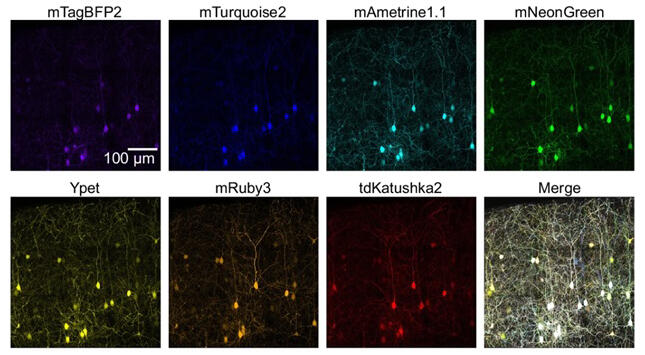To understand the mechanisms of information processing and stored information in the brain, the entire neuronal connectivity (connectome) must be analyzed at the synaptic level. In a mouse, approximately 100 million neurons are intricately intertwined. It is difficult to analyze the interconnectivity of such a large number of neurons simultaneously. Now, a research group led by Professor Takeshi Imai, Assistant Professor Marcus Leiwe (at the time of the study), Assistant Professor Satoshi Fujimoto, and Graduate Student Toshikazu Baba of the Graduate School of Medical Sciences at Kyushu University has developed a new method for the automated analysis of neuronal circuit connections using multicolor labeling. Their work was published in Nature Communications.

Provided by Kyushu University
The research group succeeded in multicolor labeling of neurons in cleared brains using a combination of seven fluorescent proteins. Even with the conventional three-color labeling method, 63 different color hues can be produced if intermediate colors are included. However, the new seven-color labeling method provides 16,384 combinations at four brightness levels, and human eyes cannot fully discriminate between them. Therefore, they developed programs for color discrimination.
In particular, they developed dCrawler, a new program capable of classifying multidimensional data, and QDyeFinder, a program that uses dCrawler to classify the color information of neurites and automatically identifies neurites with similar color combinations. Using these programs, they succeeded in the automated analysis of the connectivity of several neurites based solely on color information. The neuronal circuit connectivity analysis was substantially improved by super-multicolor labeling and the automated analysis of color hues produced by the seven primary colors. The experiments revealed the entire connectome of the mouse cerebral cortex measuring up to several square millimeters.
Imai said, "Regarding the current approach using fluorescent proteins in a simple way, we have gone as far as we can in this study. Moving forward, we would like to improve the resolution. We also want to investigate how neuronal circuits change in association with disease development in animal models of developmental disorders and neurological diseases."
Journal Information
Publication: Nature Communications
Title: Automated neuronal reconstruction with super-multicolour Tetbow labelling and threshold-based clustering of colour hues
DOI: 10.1038/s41467-024-49455-y
This article has been translated by JST with permission from The Science News Ltd. (https://sci-news.co.jp/). Unauthorized reproduction of the article and photographs is prohibited.




